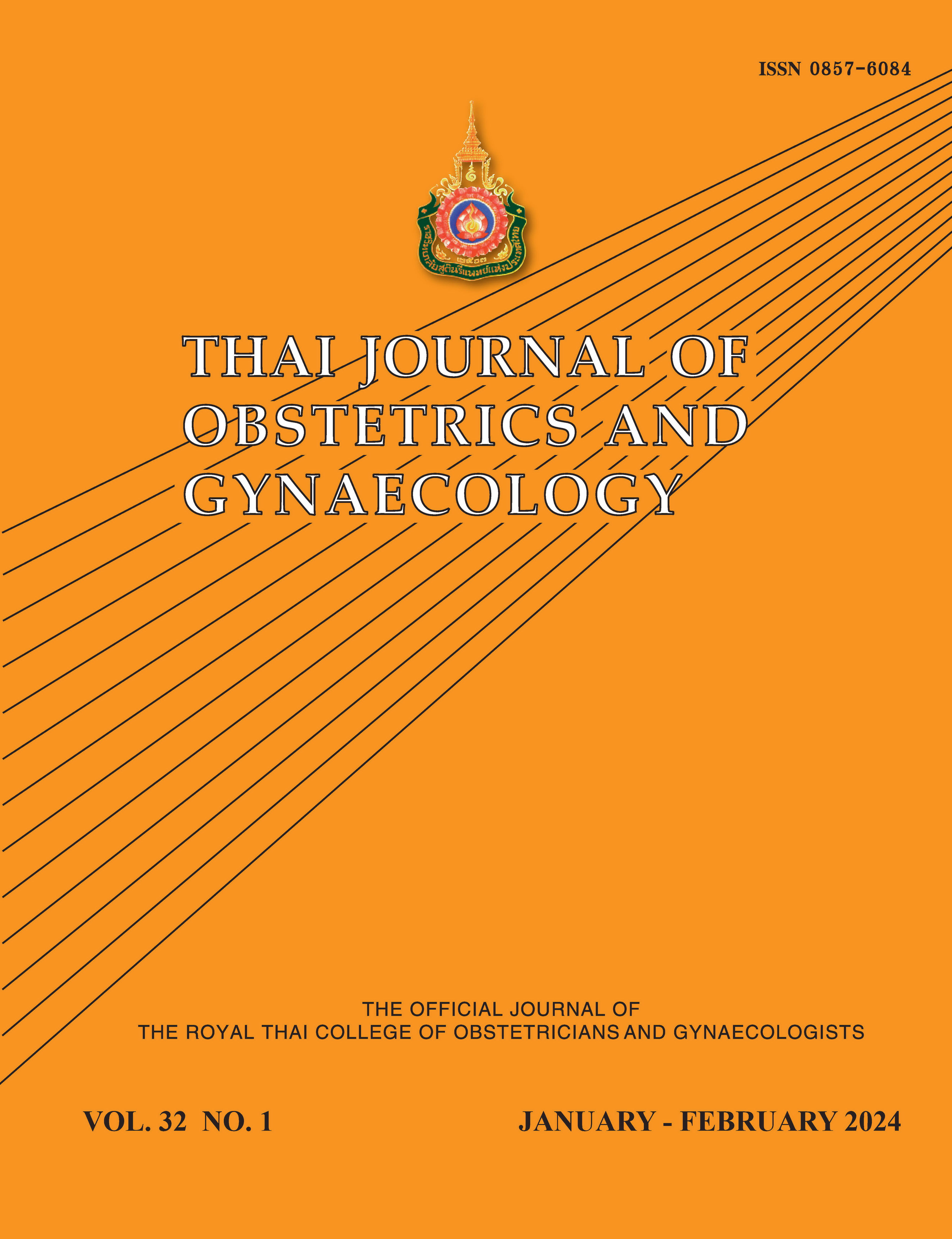Evaluation of the Episiotomy Scissors Attached with an Adjusted Angle Plate for Mediolateral Episiotomy on the Occurrence of Obstetric Anal Sphincter Injuries
Main Article Content
Abstract
Objectives: To assess the rate of obstetric anal sphincter injuries (OASI) and the angle after repair following mediolateral episiotomy performed with episiotomy scissors attached with an adjusted angle plate
Materials and Methods: The study group comprises 153 primiparous women at 37-42 weeks of gestation delivered between December 2022 and July 2023 in the labor room, Taksin Hospital. Scissors with a 60-degree adjusted angle plate were applied. Suture angles were recorded on transparent sheet and analyzed. Before suturing, a rectal exam was done to check for OASI.
Results: Of 153 primiparous women were recruited into the present study, the mean gestational age was 38.56 ± 1.06 weeks, the mean birthweight was 2,990.82 ± 327.39 grams. The mean post-suturing episiotomy angles were 44.92 ± 5.88 degrees (95 % confidence interval 44-45.9). The change in angle decreased from before cutting by 15.07±5.88 degrees. No cases of OASI were detected.
Conclusion: During childbirth, mediolateral episiotomy is performed using scissors attached to a 60-degree adjusted angle plate to cut the perineum. The mean perineal angle after suture repair was 44.9 degrees, a decrease of 15 degrees. No anal sphincter injury was detected.
Article Details

This work is licensed under a Creative Commons Attribution-NonCommercial-NoDerivatives 4.0 International License.
References
Sultan AH, Kamm MA, Hudson CN, Bartram CI. Third degree obstetric anal sphincter tears: risk factors and outcome of primary repair. BMJ 1994;304:887-91.
Walsh CJ, Mooney EF, Upton GJ, Motson RW. Incidence of third-degree perineal tears in labour and outcome after primary repair. Br J Surg 1996;83:218-21.
Andrews V, Sultan AH, Thakar R, Jones PW. Risk factors for obstetric anal sphincter injury: a prospective study. Birth 2006;33:117-22.
Klokk R, Bakken KS, Markestad T, Holten-Anderson MN. Modifiable and non-modifiable risk factors for obstetric anal sphincter injury in a Norwegian Region: a case-control study. BMC Pregnancy Childbirth 2022;22:277-83.
Fitzpatrick M, Behan M, O’Herlihy C. A randomized clinical trial comparing primary overlap with approximation repair of third-degree obstetric tears. Am J Obstet Gynecol 2000;183:1220-4.
de Leeuw JW, Vierhout ME, Struijk PC, Hop WCJ, Wallenberg HCS. Anal sphincter damage after vaginal delivery: functional outcome and risk factors for fecal incontinence. Acta Obstet Gynecol Scand 2001;80: 830-4.
Williams A. Third-degree perineal tears: risk factors and outcome after primary repair. J Obstet Gynecol 2003;23:611-4.
Dee EF, Becky G, Pavna B, Lorri M, John OLD. Fecal and urinary incontinence after vaginal delivery with anal sphincter disruption in an obstetrics unit in the United States. Am J Obstet Gynecol 2003;189:1543-50.
Baruch Y, Gold R, Eisenberg H, Amir H, Reicher L, Yogev Y. High incidence of obstetric anal sphincter injuries among immigrant women of Asian ethnicity. J Clin Med 2023;12:1044-50.
Albar M, Aviram A, Anabusi S, Huang T, Tunde-Byass M, Mei-Dan E. Maternal ethnicity and the risk of obstetrical anal sphincter injury: a retrospective cohort study. Obstetrics 2021;43:469-73.
Rizk DE, Czechowski J, Ekelund L. Dynamic assessment of pelvic floor and bony pelvis morphologic condition with the use of magnetic resonance imaging in a multiethnic, nulliparous, and healthy female population. Am J Obstet Gynecol 2004;191:83–9.
Muizzuddin N, Hellemans L, Van Overloop L, Corstjens H, Declercq L, Maes D. Structural and functional differences in barrier properties of African American, Caucasian and East Asian skin. J Dermatol Sci 2010;59:123–8.
Eogan M, Daly L, O’Connell PR, O’Herlihy C. Does the angle of episiotomy affect the incidence of anal sphincter injury? BJOG 2006;113:190-4.
Vladimir K, Karbanova J, Horak M, Lobovsky L, Kralickova M, Rokyta Z. The incision angle of mediolateral episiotomy before delivery and after repair. IJGO 2008;103:5-8.
Wiruchpongsanon P, Maharungruengrat A. Incidence of obstetric anal sphincter injuries by 60 degrees for the incision angle of mediolateral episiotomy before delivery. Thai J Obstet Gynaecol 2013;21:95-100.
Stedenfeldt M, Pirhonen J, Blix E, Wilsgaard T, Vonen B, Oian P. Episiotomy characteristics and risks for obstetric anal sphincter injuries: a case-control study. BJOG 2012;119:724-30.
van Dillen J, Spaans M, van Keijsteren W, van Dillen M, Vredevoogd C, van Huizev M, et al. A prospective multicenter audit of labor-room episiotomy and anal sphincter injury assessment in the Netherlands. Int J Gynecol Obstet 2010;108:97-100.
Cole J, Lacey L, Bulchandani S. The use of Episcissors-60 to reduce the rate of obstetric anal sphincter injuries: a systematic review. Eur J Obstet Gynecol Reprod Biol 2019;237:23-7.
Thanapongpibul C, Suksamarnwong M. Effects of Episioguide - a 60º mediolateral episiotomy guide device – on post suture episiotomy angle: a randomized controlled trial. Thai J Obstet Gynaecol 2022;30:7-14.
Sultan AH. Obstertric perineal injury and anal incontinence. Clin Risk 1999;5:193-6.
Freeman RM, Hollands, Barron LF, Kapoor DS. Cutting a mediolateral episiotomy at the correct angle: evaluation of a new device, the Episcissors-60. Med Devices Evid Res 2014;7:23-8.
Patel RP, Ubale SM. Evaluation of the angled Episcissors-60 episiotomy scissors in spontaneous vaginal deliveries. Med Devices Evid Res 2014;7:253-6.
Cole J, Lacey L, Bulchandani S. The use of Episcissors-60 to reduce the rate of obstetric anal sphincter injuries: a systematic review. Eur J Obstet Gynecol Reprod Biol 2019;237:23-7.
Andrews V, Thakar R, Sultan AH, Jones PW. Are mediolateral episiotomies actually mediolateral? BJOG 2005;112:220-4.


